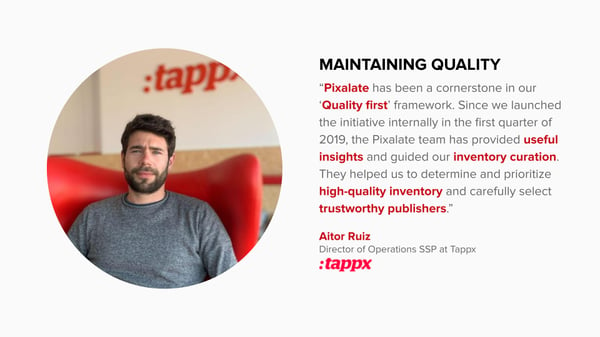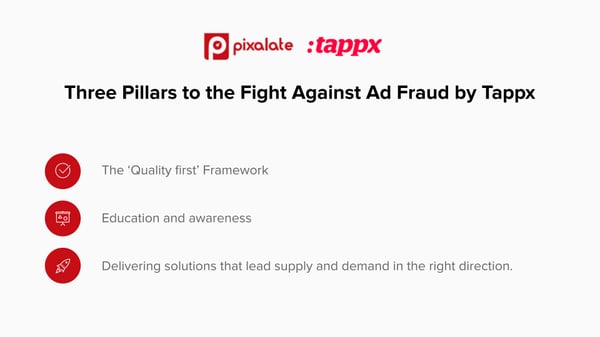
Pixalate spoke with Aitor Ruiz, Director of Operations of the Programmatic department at Tappx, about combatting invalid traffic (IVT) and ad fraud within a challenging omnichannel ecosystem.
About Aitor Ruiz:
I am Aitor Ruiz, Director of Operations of the Programmatic department at Tappx.
After earning my Licentiate degree in Economics and Business Administration from the University of Valladolid (Spain), I have spent almost 10 years in the advertising industry, for the last six years focusing exclusively on programmatic advertising.
See the full Q&A below:
Pixalate: What services does Tappx offer?
Aitor Ruiz: Tappx delivers digital advertising solutions (promotion & monetization) for the most advanced digital platforms, such as mobile, OTT/CTV and desktop. Our proprietary technology empowers publishers to maximize ad revenue and allows advertisers to reach their unique audiences.
We offer a distinct point of difference - our technology has been developed specifically for mobile and OTT markets, thereby providing brands and agencies with a higher level of reliability and transparency.
Pixalate: How does Tappx protect its customers from invalid traffic (IVT) and ad fraud?
Aitor Ruiz: Tappx’s commitment to the fight against advertising fraud is based on three pillars:
- The ‘Quality first’ framework
- Education and awareness
- Delivering solutions that lead both sides (supply and demand) in the right direction.
Tappx has been leading industry transparency rankings and currently relies on a rigorous ‘Quality first’ framework. Our ‘Quality first’ framework is an initiative launched at the beginning of 2019 to support our mission to create a better media industry by protecting and balancing the interests of publishers, advertisers and consumers. This initiative champions continuous traffic surveillance with proprietary technology and third-party solutions such as Pixalate, our primary traffic audit tool.
Pixalate has been a cornerstone in our ‘Quality first’ framework. Since we launched the initiative internally in the first quarter of 2019, the Pixalate team has provided useful insights and guided our inventory curation. They helped us to determine and prioritize high-quality inventory and carefully select trustworthy publishers. 
Pixalate: What are the key challenges in the CTV and mobile spaces right now?
Aitor Ruiz: Global ad space is facing an increase in complexity in terms of ad fraud. During the last few years, the volume and sophistication of invalid traffic have been rising significantly. Especially in the CTV environment, which is currently a predominant target for fraudsters since the value of CTV inventory is one of the highest and where regulations, standards and guidelines are still in early stages.
Pixalate: What are the key signals you look for in a good inventory source?
Aitor Ruiz: At Tappx, we analyze data putting ourselves into the advertiser's shoes, taking into account that the traffic is legit and that it passes all the anti-fraud system checks we have in place.
We usually start analyzing primary KPIs such as CTR, viewability, and frequency capping. We then continue with more sophisticated KPIs, for example, how much additional value information the request provides.
With all these insights, we can classify the traffic of the publishers we represent and provide feedback to them on how to improve the quality of their inventory. At the same time, those insights help us to recommend the best type of traffic to advertisers based on their goals.
Pixalate: Which trends do you consider as possibly the most influential on the future of programmatic advertising?
Aitor Ruiz: Privacy concerns are increasing, and contextual advertising is the solution. The digital advertising industry undoubtedly faces a paradigm shift: As we venture into a “cookieless” digital advertising ecosystem, the contextual segmentation of ad campaigns is becoming much more prevalent, more accurate and more potent. Advertisers are now afforded a new model for targeting and delivering tailored ad content that doesn’t depend on the need for personal consumer data points.
Until now, contextual analysis platforms predominantly focused on written content. However, our Contextualize-It solution has been engineered to analyze audiovisual content explicitly and its metadata at scale, which will allow advertisers to target more precisely and publishers to provide superior consumer experiences.









